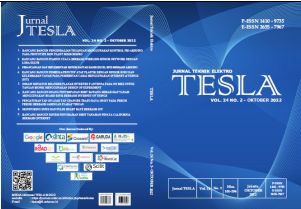DESAIN MINIATUR MEANDER PLANAR INVERTED F ANTENNA PADA 915 MHZ UNTUK TANGAN BIONIK MENGGUNAKAN DESIGN OF EXPERIMENT
Main Article Content
Abstract
To improve the quality of the bionic hands used by some disabled people, new innovations are needed. By implementing IoT in the development of bionic hands, it can make it easier for patients to obtain information, such as monitoring battery capacity, bionic hand life, and bionic hand health. So we need a component that is able to transmit this information. In this paper, we are the Meander Planar Inverted F Antenna (PIFA) at a frequency of 915 – 925 MHz which is compatible with Sigfox or LoRa IoT technology. The antenna is designed to have miniature characteristics so that it does not interfere with other components when implanted in the bionic arm and is curved so that it can follow the curved shape of the bionic arm. The miniature technique used is the winding technique and the conformal technique is used to give a curved effect to the antenna. The design is carried out very systematically by streamlining the steps using the Design of Experiment method. It is proven that it only takes 6 steps to get results that match the specifications. The simulation results show the value of S11 is -21 dB, resonant frequency is 924.9 MHz, bandwidth is 13.5 MHz, gain is -23.34 dBi and radiation pattern is omnidirectional.
Article Details

This work is licensed under a Creative Commons Attribution-NonCommercial-ShareAlike 4.0 International License.
This work is licensed under a TESLA: Jurnal Teknik Elektro Creative Commons Attribution-ShareAlike 4.0 International License. 
References
B. Abidi, A. Jilbab, and E. H. Mohamed, “Wireless body area network for health monitoring,” J. Med. Eng. Technol., vol. 43, no. 2, pp. 124–132, 2019, doi: 10.1080/03091902.2019.1620354.
M. I. Ahmed and M. F. Ahmed, “A wearable flexible antenna integrated on a smart watch for 5g applications,” J. Phys. Conf. Ser., vol. 1447, no. 1, 2020, doi: 10.1088/1742-6596/1447/1/012005.
Anjali and K. Amrit, “Performance analysis of patch and pifa antenna for wcs and sdr applications,” Int. J. Adv. Res. Comput. Commun. Eng., vol. 6, no. 7, pp. 265–269, 2017.
E. Pietrosemoli, “Wireless standards for iot: wifi, ble, sigfox, nb-iot and lora.” International Centre for Theoritical Physics, 2017. [Online]. Available: http://wireless.ictp.it/school_2017/Slides/IoTWirelessStandards.pdf.
S. Al-Sarawi, M. Anbar, K. Alieyan, Alzubaidi, and Mahmood, “Internet of things (iot) communication protocols : review,” 2017 8th Int. Conf. Inf. Technol., pp. 697–702, 2017.
L. J. Xu, Y. X. Guo, and W. Wu, “Miniaturized circularly polarized loop antenna for biomedical applications,” IEEE Trans. Antennas Propag., vol. 63, no. 3, pp. 922–930, 2015, doi: 10.1109/TAP.2014.2387420.
A. Di Serio et al., “Potential of sub-ghzwireless for future iot wearables and design of compact 915 mhz antenna,” Sensors (Switzerland), vol. 18, no. 1, pp. 1–25, 2018, doi: 10.3390/s18010022.
P. Soontornpipit, “Design and delevopment of a dual-band pifa antenna for brain interface applications,” 2019 Int. Electr. Eng. Congr. (iEECON 2019), 2019.
F. Gozasht and A. S. Mohan, “Miniaturized slot pifa antenna for tripleband implantable biomedical applications,” IEEE MTT-S Int. Microw. Work. Ser. RF Wirel. Technol. Biomed. Healthc. Appl. IMWS-BIO 2013 - Proc., vol. 2, pp. 2–4, 2013.
H. Sajjad, W. T. Sethi, S. Khan, and L. Jan, “Compact dual-band implantable antenna for e-health monitoring,” Int. Symp. Wirel. Syst. Networks, ISWSN, pp. 1–4, 2017.
J. Shang, Y. Yu, and L. J. Xu, “Compact bual-band implantable planar inverted-f antenna with bandwidth enhancement,” Microw. Opt. Technol. Lett., 2019.
M. Leeban Moses, C. Raju, and A. R. Nair, “Detection of skin cancer using pifa antenna,” IOP Conf. Ser. Mater. Sci. Eng., vol. 764, no. 1, 2020.
T. Prakoso, I. A. Utami, I. Santoso, M. A. Riyadi, and M. Facta, “Systematic tuning of coupled-line filter using doe method,” Proc. - 2018 3rd Int. Conf. Inf. Technol. Inf. Syst. Electr. Eng. ICITISEE 2018, vol. 21, no. ii, pp. 391–395, 2018, doi: 10.1109/ICITISEE.2018.8720981.
L. Y. Sabila, T. Prakoso, and M. A. Riyadi, “Design of 2.4 ghz-band meander planar inverted f antenna for bionic hand using doe method,” pp. 1–6, 2021, doi: 10.1109/isesd53023.2021.9501861.
P. Lopez, D. Fernandez, A. J. Jara, and A. F. Skarmeta, “Survey of internet of things technologies for clinical environments,” Proc. - 27th Int. Conf. Adv. Inf. Netw. Appl. Work. WAINA, pp. 1349–1354, 2013.
S. Y. Jun, A. Elibiary, B. Sanz-Izquierdo, L. Winchester, D. Bird, and A. McCleland, “3D printing of conformal antennas for diversity wrist worn applications,” IEEE Trans. Components, Packag. Manuf. Technol., vol. 8, no. 12, pp. 2227–2235, 2018.
P. Chopra, M. Bhandari, K. S. Beenamole, and S. Saxena, “Design of an x-band conformal antenna using microstrip patches,” 2nd Int. Conf. Signal Process. Integr. Networks, SPIN 2015, pp. 83–87, 2015, doi: 10.1109/SPIN.2015.7095393.
M. M. Miran and F. Arifin, “Design and performance analysis of a miniaturized implantable pifa for wireless body area network applications,” 1st Int. Conf. Robot. Electr. Signal Process. Tech. ICREST, pp. 253–257, 2019.
I. Gil and R. Fernández-García, “Flexible pifa antenna design for wireless sensor networks in wearable healthcare applications,” Prog. Electromagn. Res. Symp., pp. 1017–1019, 2015.
S. Rana, A. Thakur, H. S. Saini, R. Kumar, and N. Kumar, “A wideband planar inverted f antenna for wireless communication devices,” Proc. - Int. Conf. Adv. Comput. Commun. Autom., pp. 1–3, 2016.



